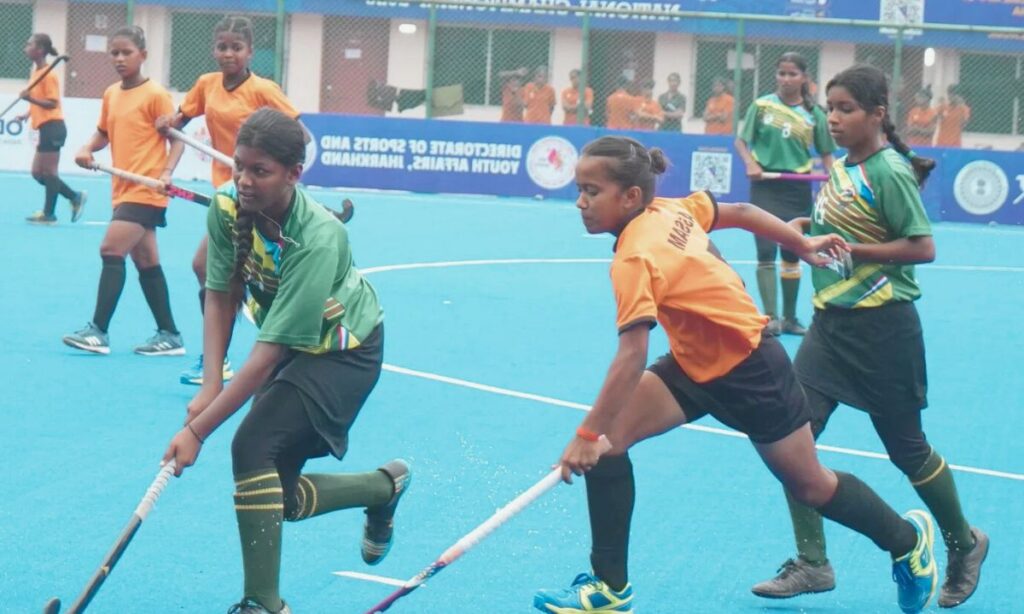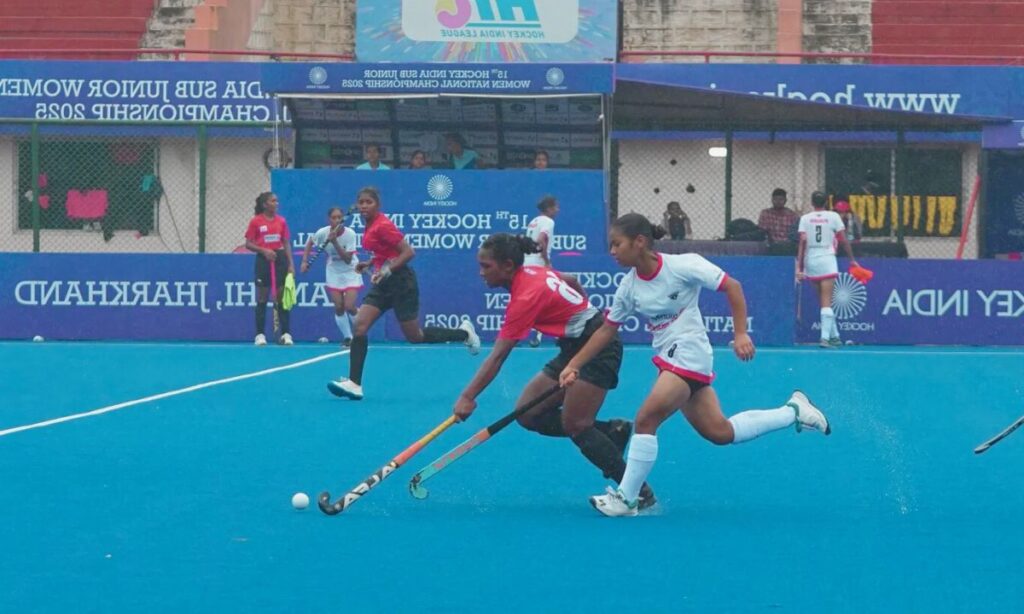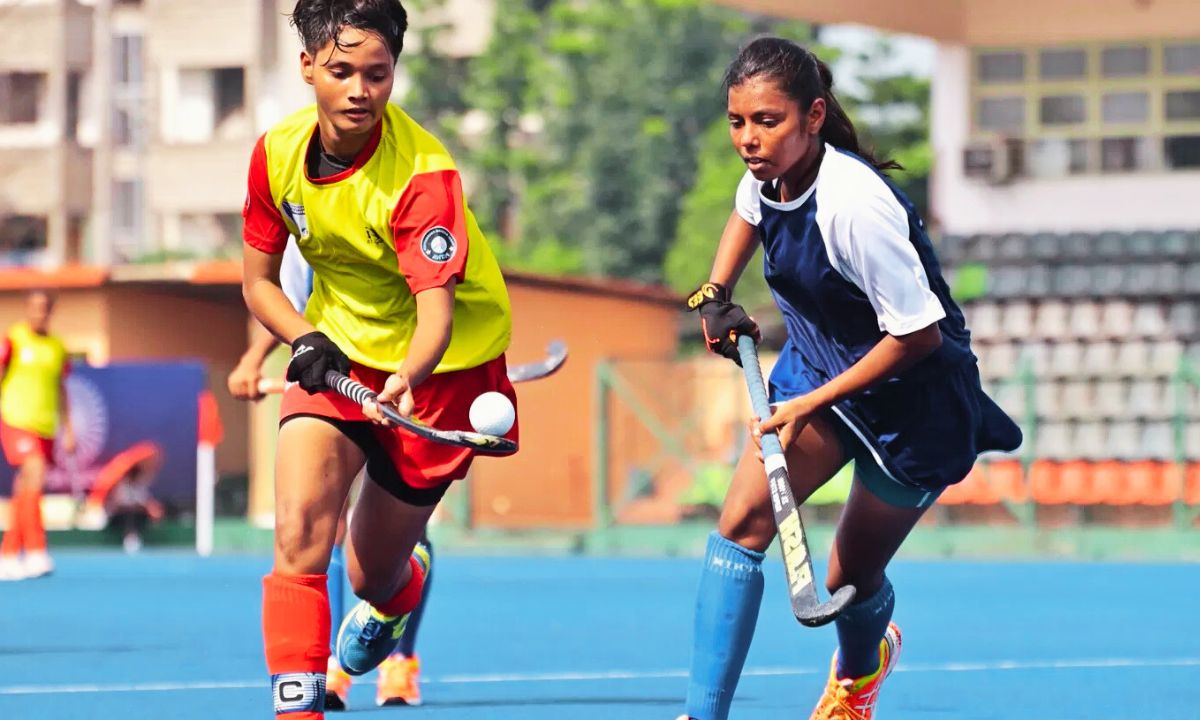The 15th Hockey India Sub Junior Women National Championship kicked off in Ranchi from July 3 to 14, 2025. This edition felt electric, with youth teams across India delivering vibrant performances, volatile scorelines and unforgettable moments. Over twelve days of play, emerging female athletes transformed pitches into their stage—with aspirations, raw energy and hunger to shine.
Opening Day Explosions and Dominance in Lower Divisions
On the first day, divisions C and B delivered explosive action. Hockey Himachal humbled Hockey Rajasthan 7‑0 in Division C, featuring a hat‑trick by Navneet Kaur and braces by Riya. Assam Hockey demolished Goans Hockey 7‑1, driven by twin hat‑tricks from Ritika Tigga and Jyoshna Ekka. Telangana drew 2‑2 with Jammu & Kashmir. In Division B, Karnataka beat Kerala 3‑1, Manipur edged out Dadra & Nagar Haveli‑Daman & Diu 3‑0, and Gujarat overcame Bengal 3‑0
Division A – Group Stage Action and Tight Pools
Division A featured top state units including Jharkhand, Odisha, Haryana and Mizoram. Odisha began with a 3‑0 win over Maharashtra. Uttar Pradesh pulled off a 3‑2 win versus Madhya Pradesh in a tight battle. Jharkhand and Haryana drew 1‑1, while Mizoram earned a forfeit win over Delhi
Rising Stars and Group Drama
Mizoram then thrashed Delhi 4‑0; Captain Vanlalrinhlui was outstanding with goals in the 13th and 34th minutes. Bihar followed with an emphatic 6‑0 victory over Delhi, powered by Pushpanjali Kumari’s hat‑trick and Sidhi Kumari’s brace. These performances reshuffled the standings and intensified the competition. Division A pools were truly unpredictable, setting the stage for quarterfinal showdowns

Quarter‑Final Battle Lines Are Drawn
As the championship reached knockout mode, the quarterfinal pairings posed stiff challenges: UP vs Haryana, Odisha vs Bihar, Mizoram vs Punjab, and champions Jharkhand against Madhya Pradesh. Eight intense games, each loaded with pressure and ambition, promised to eliminate and elevate promising teams
Semi‑Final Drama in Ranchi
On July 12, Odisha edged Haryana 1‑0 thanks to Sudipa Baa’s 45th‑minute strike. In the second semifinal, Jharkhand beat Mizoram 1‑0, with Jirn Soy Munda delivering the crucial goal in the 26th minute. Two tight, tactical affairs confirmed the finalists: Odisha and Jharkhand
Nerve‑Wracking 3rd/4th Place Play‑Off
The bronze medal match saw Haryana and Mizoram locked 3‑3 at full time. K Vanlalpeki opened for Mizoram, but Haryana’s Bhavya, Durga and Manjinder responded fiercely. At the last whistle, Mizoram forced draws with Laldinpuli’s back‑to‑back goals in stoppage time. In the shoot‑out, Haryana prevailed 5‑4—thanks to sharp saves from goalkeeper Saina and flawless penalty conversions. This gritty finish awarded Hockey Haryana a hard‑earned podium spot
Electrifying Final Lifted by Home‑Team Heroics
In a memorable final, Hockey Jharkhand defeated Odisha 1‑0. Jirn Soy Munda’s 27th‑minute strike lit up home turf, sealing a championship on local soil. Strong defensive resolve on both sides created a tense match; Jharkhand’s persistent shape and disciplined structure ultimately delivered them the title
Champions’ Snapshot – Hockey Jharkhand
Jharkhand’s journey combined tactical clarity, poise under pressure, and defensive discipline. Their consistent form through all stages showcased maturity. Home advantage added emotional zeal, but it was the team’s cohesion and mindset that emerged as the decisive edge.
Odisha’s Silver Run and Poignant Final Glimmer
Though Odisha fell just short in the final, their campaign showed grit and tactical maturity. Sudipa Baa’s earlier semifinal strike and sustained teamwork solidified their path to silver. Their performance signals growing strength in states investing in young women’s hockey.
Bronze Glory for Haryana
Haryana’s bronze was earned through spirited fightback and nerve. Scoring three goals in the regular match and winning the shoot‑out illustrated resilience. The team transformed pressure into performance, and goalkeeper Saina’s heroics added emotional triumph to their campaign.
Emerging Stars Lighting Up the Championship
This tournament unearthed goal‑scoring talent across divisions: Manpreet Kaur’s four‑goal display for Chhattisgarh, Jyoshna Ekka and Ritika Tigga’s hat‑tricks for Assam, and Vanlalrinhlui’s brace for Mizoram stood out. Young women printed their names on the scoreboard and on the national radar
Structure and Significance of Sub‑Junior Championships
With 28 teams across three divisions (A, B, C), this championship promotes fair competition and upward mobility. Division A features elite states; B and C are breeding grounds for future talent. Promotion and relegation ensure dynamic competition and development across states
Why This Tournament Matters for Indian Women’s Hockey
These Sub‑Junior Championships are crucial in shaping India’s future for women’s hockey. The competition provides real‑match experience, exposes emerging talent to pressure, and builds the pipeline for junior and senior national teams.
Emotional Highs, Grit and Future Aspirations
From Jirn Soy Munda’s championship goal to the heartbreak in shoot‑outs, this event was packed with emotion. Each match offered moments to savor: powerful strikes, flurry of passes, breathless finishes. These visceral experiences define young athletes, forging resolve and ambition.
Learning Curves and Strategic Takeaways
Teams showcased tactical layouts, counter‑attacks, defensive structure and stamina. Coaches emphasized structure, fitness, and mental resilience. This event was a learning curve—for players and officials alike—preparing them for higher levels of competition.
What Comes Next for These Young Stars
Winners like Jharkhand, Odisha and Haryana will now move to Division A next year or push for sustained success. The standout performers carry momentum into junior nationals, academy draws or even India junior camps. This stage is merely the beginning.
Behind the Benches – Coaches Who Shaped the Game
One of the tournament’s most overlooked strengths was the role of the coaches guiding these young squads. With limited resources, many state coaches had to rely on sheer motivation and technical knowledge to prepare their girls. Jharkhand’s coaching team, in particular, emphasized communication, structure, and conditioning. Odisha’s focus on fast transitions and controlling midfield paid off in tight matches. Haryana’s team drilled shootout scenarios—a move that earned them bronze. These mentors were more than strategists; they were motivators, counselors, and protectors, fostering both athleticism and character.
How Ranchi Brought the Tournament Alive
The city of Ranchi turned into a festival zone during the championship. Local fans thronged the stands, cheering not just for Jharkhand but for the spirit of Indian women’s hockey. The stadium atmosphere was electric—horns blaring, drums beating, and chants echoing across the turf. Vendors sold regional snacks, creating a blend of sport and culture. Families came out in groups, creating a community experience. For young players, it was a taste of what professional hockey feels like. The turnout reaffirmed why grassroots hockey thrives in Jharkhand and nearby states.
Unsung Heroes: Goalkeepers Who Made the Difference
While goal scorers usually steal headlines, goalkeepers played a defining role in this tournament. Haryana’s Saina saved crucial shootout penalties under intense pressure. Jharkhand’s keeper stopped Odisha’s best attempts in the final with incredible composure. Even teams that didn’t make the semifinals had standout moments—Mizoram’s Laldinpuli made 15 saves in a single game. These performances underlined how goalkeeping has evolved at the sub-junior level. With better coaching and more match exposure, India is developing a new generation of brave, athletic goalkeepers ready for international stages.
Medical and Support Teams: The Silent Backbone
Another uncelebrated element was the support staff. Physios, medical experts, and logistics managers ensured players stayed healthy throughout the exhausting schedule. Jharkhand’s physio team worked tirelessly with ice packs and muscle recovery techniques, especially during the high-stakes knockout games. Odisha’s girls were observed undergoing advanced hydration and warm-up routines, reflecting growing professionalism even at junior levels. These unseen contributors made the tournament smoother and safer, providing an environment where young athletes could focus entirely on their game.
Tactical Variations Across States
One interesting aspect was how different states approached the game tactically. Teams like Odisha emphasized high-pressing play, pushing opponents into mistakes. Jharkhand, on the other hand, relied on counter-attacks and zonal defense. Haryana focused on midfield overloads, whereas Mizoram opted for fast flanks and long aerial passes. These differences in style brought color and unpredictability to every match. This regional diversity in tactics reflects a healthy, evolving national system—one that doesn’t follow a single mold but embraces innovation from every corner of India.
Player Spotlight: Jirn Soy Munda – A Star in the Making
Jirn Soy Munda, who scored the winning goal in the final, had a phenomenal tournament. Her composure, speed, and intelligence made her stand out throughout. But it wasn’t just the goal that earned her praise—it was her consistency. She dropped deep to defend when needed, played the perfect through balls, and maintained leadership on and off the pitch. Scouts and coaches have already begun tracking her progress. If groomed properly, Jirn could become a future national team asset, continuing Jharkhand’s tradition of producing hockey legends.
How the Championship Inspired Local Girls
This tournament wasn’t just about the players; it inspired hundreds of young girls in and around Ranchi. Many local schoolgirls were seen practicing hockey with borrowed sticks, trying to mimic their heroes. For a region where girls’ participation in sport still faces societal hurdles, the event served as a catalyst for change. NGOs and local sports bodies are now planning to set up more training camps and offer scholarships. This ripple effect could be the tournament’s most valuable legacy—empowering a generation to believe that hockey is a viable dream.
Media Coverage and Growing Attention
Compared to previous years, this edition received better media attention. Websites like SportGlub.com, Hockey India’s official portal, and national news agencies published daily updates, interviews, and photos. Live score updates on digital platforms helped fans across India stay connected. With growing interest, there is now talk of broadcasting future junior tournaments live. The media’s expanding role doesn’t just boost visibility—it also helps create heroes and icons for aspiring girls. Consistent coverage could transform sub-junior championships into mainstream events.
Challenges Faced by Lower-Division Teams
Teams in Division B and C, such as Telangana, Assam, and Gujarat, faced real challenges—limited infrastructure, fewer training matches, and travel fatigue. Some arrived late due to train delays or poor coordination, impacting their early games. Despite this, many players showed heart and raw potential. Their coaches expressed hope that participation itself will motivate state bodies to invest more. These states are rich in talent but require structured planning, better coaching, and financial backing to climb into Division A.
Psychological Impact of Knockouts
The knockout rounds brought emotional highs and lows. Players were seen crying, consoling each other, or pumping fists in celebration. For many, this was their first taste of intense competition—and the mental toll was real. Jharkhand’s coach highlighted the team’s pre-match sessions on mental preparation, breathing exercises, and visualization. Odisha too had a sports psychologist guide players before the semifinals. These techniques are increasingly becoming part of junior development, underlining that mental strength is as vital as physical skill in high-stakes tournaments.
Role of Parents and Families
Behind every young athlete was a supportive family. Parents traveled from distant districts—some selling livestock or borrowing funds—to be in Ranchi and cheer from the sidelines. Their presence uplifted the players. Some even brought homemade food to maintain their daughters’ nutrition. This silent network of sacrifices shows how grassroots sport in India still runs on pure passion and parental belief. Acknowledging these unsung supporters is essential to understanding the ecosystem of junior women’s hockey in India.
Nutrition and Fitness – New Priorities
Fitness levels across the top teams were visibly better than in past editions. This can be credited to better nutritional planning and physical training. Players from Odisha and Haryana spoke about diet charts and strength conditioning sessions. States are beginning to understand that even at the sub-junior level, proper fitness routines can reduce injuries and boost stamina. With national-level nutrition guidelines likely to be introduced soon, young players may now receive structured support instead of relying solely on home-cooked food.
Scouting and Selection for India Juniors
Selectors from Hockey India were present at almost every game. They took notes, recorded matches, and interacted with coaches post-game. This championship doubled as a scouting platform for the India junior women’s team. Players like Pushpanjali Kumari (Bihar), Ritika Tigga (Assam), and Vanlalrinhlui (Mizoram) were seen as prospects. With the Junior Asia Cup on the horizon, performances here could lead to India call-ups. This pathway shows that sub-junior tournaments are not isolated events—they are now the frontlines of national team building.
Evolution of Umpiring and Officiating
Another important highlight was the improved level of officiating. Umpires were consistent, followed modern rules strictly, and avoided controversies. The tournament had fewer yellow cards, smoother substitutions, and better communication between players and referees. This growth in officiating quality reflects training by Hockey India’s referee board. Future plans include technology-assisted replays, better video analysis, and pre-match umpire briefings. These upgrades are essential if India’s sub-junior ecosystem wants to align with international hockey standards.

Technology’s Quiet Rise in Junior Hockey
While it wasn’t a tech-heavy tournament, signs of digital evolution were visible throughout. Coaches used tablets to track formations, substitutions, and penalty corner strategies. Some teams even reviewed footage between games to spot tactical flaws or plan counters. Jharkhand’s staff credited basic video analysis as one reason they stayed ahead tactically. Though still in early stages, this subtle tech integration marks a significant shift in India’s grassroots hockey—where analytical thinking is slowly replacing guesswork and instinct.
Building Leadership at a Young Age
Leadership was a recurring theme. Team captains weren’t just figureheads—they were motivators, mediators, and strategists. Jharkhand’s captain led from the front, keeping morale high even under pressure. Odisha’s skipper was seen comforting younger teammates after a tough loss, showing maturity beyond her years. Leadership experiences like these shape personality, resilience, and accountability—traits that go beyond the hockey field. Developing such leaders at sub-junior level will eventually build stronger senior squads for India in international competitions.
Bridging the Urban-Rural Divide in Talent
What stood out in Ranchi was how rural India is becoming the real nursery for women’s hockey. Many star players came from tribal belts, small villages, or underfunded districts. Despite fewer facilities, their passion and raw athleticism were unmatched. These girls often train on uneven grounds or cement floors, using borrowed gear. Yet, they outperformed counterparts from better-equipped urban programs. This shows that the future of Indian women’s hockey lies not in big cities but in its heartland—waiting to be nurtured with proper support.
The Emotional Farewell – A Tournament That Changed Lives
As the final whistle blew in Ranchi, there were tears—some of joy, others of heartbreak. For many players, this was their first taste of success, failure, and everything in between. Coaches hugged their squads tightly, parents waved from stands, and volunteers clicked photos to preserve memories. These emotional goodbyes weren’t just about a tournament ending—they marked a transition. Young girls who entered as hopefuls left as hardened competitors, ready for bigger arenas, bolder dreams, and the next chapter of their journey.
Why This Tournament Matters More Than Ever
In a time when women’s sports still struggle for equal footing, events like the Sub Junior Championship are more than competitions—they’re statements. They prove that Indian girls, if given platforms, can excel, inspire, and transform. This tournament wasn’t just about goals scored or matches won; it was about changing narratives. It showed that hockey is not just a game—it’s a medium of empowerment, self-worth, and national pride. The ripples of Ranchi 2025 will continue long after the medals are packed away.
Conclusion: A Championship That Sparked Hope
The 15th Hockey India Sub Junior Women Championship was more than a tournament—it was a celebration of hungry talent, evocative goals, and emotional growth. Jharkhand’s triumph, Odisha’s silver‑lined run and Haryana’s gritty bronze all underscore how competition breeds excellence. With young stars already lighting up the field, India’s future in women’s hockey looks bold, bright and beautifully unpredictable.


1 thought on “Thrilling Upsets Meet Stellar Triumphs: Power‑Packed Sub Junior Women Hockey in Ranchi”